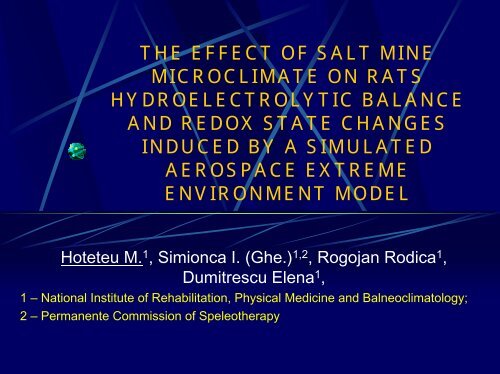the simulated aerospace extreme environment model
the simulated aerospace extreme environment model
the simulated aerospace extreme environment model
Create successful ePaper yourself
Turn your PDF publications into a flip-book with our unique Google optimized e-Paper software.
THE EFFECT OF SALT MINE<br />
MICROCLIMATE ON RATS<br />
HYDROELECTROLYTIC BALANCE<br />
AND REDOX STATE CHANGES<br />
INDUCED BY A SIMULATED<br />
AEROSPACE EXTREME<br />
ENVIRONMENT MODEL<br />
Hoteteu M. 1 , Simionca I. (Ghe.) 1,2 , Rogojan Rodica 1 ,<br />
Dumitrescu Elena 1 ,<br />
1 – National Institute of Rehabilitation, Physical Medicine and Balneoclimatology;<br />
2 – Permanente Commission of Speleo<strong>the</strong>rapy
The aim of study<br />
The study show <strong>the</strong> role of <strong>the</strong> salt mine<br />
microclimate in <strong>the</strong> correction process of<br />
physiological disturbances which appear in<br />
<strong>the</strong> hydroelectrolytic balance and redox state<br />
of animal organism as follow <strong>the</strong> action of a<br />
complex <strong>aerospace</strong> <strong>simulated</strong> <strong>environment</strong>al<br />
factors (hipergravity, radiations, hipobaric<br />
hypoxia, high temperature, microbiological<br />
risk and <strong>simulated</strong> microgravity).
Material and methods<br />
The study was performed on 48 Wistar white<br />
rats divided in experimental and control<br />
group.
THE SIMULATED AEROSPACE<br />
EXTREME ENVIRONMENT MODEL<br />
Radiations Radiations<br />
Microbiologic<br />
icrobiological al risk<br />
Hipergravity<br />
Hipergravit<br />
Hypobaric hypoxia and temperature<br />
temperatur<br />
Microgravity<br />
Microgravit
Hipergravity<br />
Centrifugation +4Gz for 4h
Hypobaric hypoxia and temperature<br />
300 mmHg, +45°C, +45 30 min
Hipogravity, Hipogravity,<br />
cosmic radiations and<br />
microbiological risk<br />
Microgravity Microgravit – 24 h water immersion<br />
Cosmic radiations – gamma radiations 1.5 5 Gy<br />
Microbiological risk – Staphylococcus aureus
Salt mine microclimate<br />
Slanic Prahova “Unirea Unirea” salt mine
Biochemical methods (I)<br />
To study <strong>the</strong> hydroelectrolytic balance <strong>the</strong><br />
rats were keeped for 24h in metabolic cages,<br />
without food and with free access to a saline<br />
solutions. It was measured <strong>the</strong> volume of<br />
water and <strong>the</strong> amount of sodium ingested.<br />
The urinary concentrations of sodium and<br />
potassium were assayed using a Ciba<br />
Corning 480 flamephotometer. From <strong>the</strong> data<br />
obtained it was calculated <strong>the</strong> electrolytes<br />
ratio which expresses mineralocorticoid<br />
functional level of <strong>the</strong> organism in<br />
experimental conditions.
Biochemical methods (II)<br />
The blood probes were prelevated<br />
immediately and in a 24 hours interval after<br />
<strong>the</strong> exposure to experimental conditions.<br />
The catalase and superoxide dismutase<br />
activity was assayed by Beers-Sizer<br />
Beers Sizer and<br />
Kellog-Fridovich Kellog Fridovich spectrophotometric<br />
methods.<br />
method
Results<br />
1. Sodium ingestion and renal elimination<br />
2. Renal elimination of potassium<br />
3. Hydric balance<br />
4. Mineralocorticoid function of adrenals<br />
5. Enzymic activity of blood superoxid<br />
dismutase and catalase
Fig. 1 The influence of <strong>the</strong> Salt Mine „Unirea Unirea” Slanic Prahova<br />
microclimate on <strong>the</strong> sodium balance in Wistar rats after exposure<br />
to <strong>the</strong> <strong>simulated</strong> <strong>aerospace</strong> <strong>environment</strong>al factors
Fig. 2 The influence of <strong>the</strong> Salt Mine „Unirea Unirea” Slanic Prahova<br />
microclimate on <strong>the</strong> renal potassium elimination in Wistar rats<br />
after exposure to <strong>the</strong> <strong>simulated</strong> <strong>aerospace</strong> <strong>environment</strong>al factors
Fig. 3 The influence of <strong>the</strong> Salt Mine „Unirea Unirea” Slanic Prahova<br />
microclimate on <strong>the</strong> hydric balance in Wistar rats after exposure<br />
to <strong>the</strong> <strong>simulated</strong> <strong>aerospace</strong> <strong>environment</strong>al factors
Fig. 4 The influence of <strong>the</strong> Salt Mine „Unirea Unirea” microclimate on<br />
<strong>the</strong> urinary concentration of electrolytes in Wistar rats after<br />
exposure to <strong>the</strong> <strong>simulated</strong> <strong>aerospace</strong> <strong>environment</strong>al factors
Fig. 5 The influence of <strong>the</strong> Salt Mine „Unirea Unirea” Slanic Prahova<br />
microclimate on <strong>the</strong> ratio of urinary electrolytes concentration in<br />
Wistar rats after exposure to <strong>the</strong> <strong>simulated</strong> <strong>aerospace</strong><br />
<strong>environment</strong>al factors
Fig. 6 The influence of <strong>the</strong> Salt Mine „Unirea Unirea” Slanic Prahova<br />
microclimate on <strong>the</strong> blood activity of catalase in Wistar rats after<br />
exposure to <strong>the</strong> <strong>simulated</strong> <strong>aerospace</strong> <strong>environment</strong>al factors
Fig. 7 The influence of <strong>the</strong> Salt Mine „Unirea Unirea” Slanic Prahova<br />
microclimate on <strong>the</strong> blood activity of superoxid dismutase in<br />
Wistar rats after exposure to <strong>the</strong> <strong>simulated</strong> <strong>aerospace</strong><br />
<strong>environment</strong>al factors
Conclusion<br />
The saline load of rats using <strong>the</strong> salt mine<br />
microclimate allowed <strong>the</strong> correction of dehidration<br />
and negative balance of electrolytes which appear<br />
after <strong>the</strong> action of <strong>the</strong> <strong>aerospace</strong> <strong>simulated</strong><br />
<strong>environment</strong>al factors complex.<br />
The <strong>simulated</strong> <strong>aerospace</strong> <strong>extreme</strong> <strong>environment</strong><br />
<strong>model</strong>, induce <strong>the</strong> increase of superoxide<br />
dismutase and catalase activity in blood and <strong>the</strong>se<br />
tendencies was increased by <strong>the</strong> action of <strong>the</strong> salt<br />
mine microclimate.

















